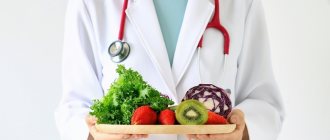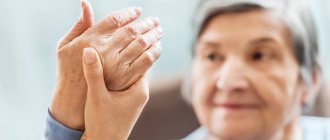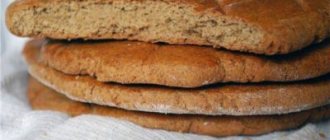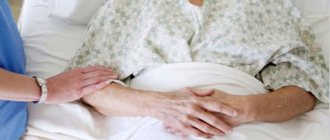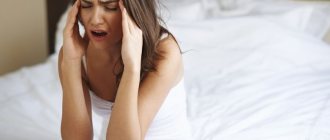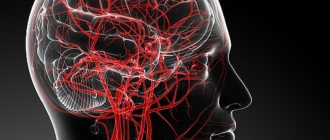Stroke prevention involves eliminating risk factors, drug therapy for underlying diseases, and performing exercises that strengthen the condition of the blood vessels in the brain. Doctors at the Yusupov Hospital take an individual approach to preventing vascular complications in each patient. In order to take into account all risk factors, neurologists and cardiologists carefully examine patients using modern devices produced by leading companies in Europe, Japan and the USA.
In order to avoid a stroke, you should know the causes that can cause acute cerebrovascular accident. The risk of stroke increases:
- age: after 50 years, every decade of life increases the likelihood of developing a stroke by 2 times;
- complicated heredity: the risk of stroke doubles if you have relatives who have suffered acute cerebrovascular accident;
- arrhythmia: 5% of patients suffering from cardiac arrhythmias develop ischemic stroke;
- narrowing or blockage of the carotid arteries and an increased tendency to form blood clots lead to stroke in 5-7% of patients;
- Arterial hypertension is one of the main causes of hemorrhagic stroke.
Patients who are at risk for the above parameters, after contacting the Yusupov Hospital, undergo an examination, which includes:
- ultrasound examination of large vessels (primarily the carotid arteries);
- electrocardiography;
- echocardiography;
- detailed blood tests to determine the lipid profile and susceptibility to thrombosis;
- determination of the level of homocysteine - an amino acid that leads to early atherosclerosis and the formation of blood clots. It increases the likelihood of stroke and heart attack by 5–8 times;
- computer and magnetic resonance therapy;
- duplex study of cerebral vessels;
- video electroencephalography;
- neuromyography;
- 24-hour Holter monitoring, arterial monitoring and ECG.
You can prevent a stroke by promptly consulting a doctor. Neurologists at the Yusupov Hospital examine a patient for a stroke if the following symptoms are present:
- sudden, temporary weakness or numbness of the limbs;
- short-term speech difficulties;
- periodic impairment of visual acuity;
- diplopia (double vision);
- imbalance or dizziness.
Primary prevention of stroke
Primary prevention of stroke is a system of measures aimed at preventing the first cardiovascular catastrophe. Doctors at the Yusupov Hospital recommend that patients use all methods of influencing areas of their lives that reduce the negative impact of traditional risk factors. The axiom is the formula: weight loss + quitting smoking nicotine + physical activity is more effective than medications. Lifestyle changes combined with regular, evidence-based preventive drug therapy can prevent stroke and add an additional 8-10 years to life.
How to Prevent Stroke with Medicines
There are the following types of drugs intended for the prevention of stroke:
- antihypertensive drugs (Enalapril, Lisinopril, etc.). Dosage and methods of administration are prescribed only by a doctor;
- antiplatelet agents (Thromboass, Cardiomagnyl, Aspirin). Designed to prevent the formation of blood clots and reduction of vascular lumens. The drugs are also prescribed by a doctor, most often prescribed according to the following scheme: a month on and a month off;
- diuretics (Lasix, Furosemide, etc.) help reduce swelling by removing excess sodium from the body.
The regimen and dosage of medications is prescribed only by the attending physician; in no case should you choose everything yourself: you can only worsen your health or even cause irreparable harm! The specialist analyzes the individual characteristics of the body, studies the medical history and looks at the results of the latest tests, all this allows you to understand the current clinical picture and choose the right treatment.
How to prevent a cerebral stroke with the help of drugs, we will discuss below:
| A drug | Name | Dosage | Contraindications |
| Beta blockers | Metoprolol | 2 times a day 70 mg | Cardiogenic shock, acute heart failure, pregnancy, respiratory pathologies, arterial hypotension. |
| Anaprilin | 2 times a day 40 mg | Arterial hypotension, pregnancy, sinus bradycardia, diabetes mellitus. | |
| Atenolol | 1 time per day 25–50 mg | Bradycardia, respiratory pathologies, thyrotoxicosis, pregnancy, diabetes mellitus, acute heart failure. | |
| Sedatives | Valerian | 3 times a day, 2 tablets | Fructose and lactose intolerance, component intolerance, pregnancy. |
| Novo-passit | 3 times a day, 1 tablet | Asthenic bulbar palsy, intolerance to components, gastrointestinal pathologies, head injuries. | |
| Persen | 3 times a day, 1 tablet | Pregnancy, cholelithiasis, arterial hypotension, lactose and fructose intolerance. | |
| Calcium antagonists | Verapamil | 3 times a day 40 mg | Severe bradycardia, arterial hypotension, pregnancy. |
| Nifedipine | 3 times a day, 1 tablet | Tachycardia, stenosis, arterial hypotension, tachycardia, acute heart attack, pregnancy. | |
| Nootropic | Glycine | 3 times a day, 1 tablet | Intolerance to components. |
| Pyritinol | 3 times a day 200 mg | Intolerance to components, liver and kidney pathologies, autoimmune diseases in the acute stage. | |
| Pantogam | 2 times a day, 1 tablet | Pregnancy, intolerance to components, acute kidney disease. | |
| Antiplatelet | Aspecard | 1 tablet once a day | Kidney and liver failure, intestinal ulcers, hemophilia, vitamin K deficiency. |
| Cardiomagnyl | 1 tablet once a day | Intolerance to components, kidney pathologies, ulcers, predisposition to bleeding. |
Attention! Treatment with a specific drug and dosage can only be prescribed by a doctor. Before using the presented drugs, it is necessary to conduct a comprehensive examination in order to reduce the risk of side effects and eliminate contraindications.
We recommend
“Centers for pensioners: what they are and how to get there” Read more
Drug therapy
What medicine should I take to prevent a stroke? Cardiologists at the Yusupov Hospital carry out stroke prevention in patients suffering from diseases of the cardiovascular system in three areas:
- use of antihypertensive drugs;
- treatment with statins;
- antithrombotic therapy.
Antithrombotic therapy is the most effective. It has the following goal: preventing the formation of blood clots inside blood vessels and preventing stroke. In the clinical practice of cardiologists at the Yusupov Hospital, the following antithromboplatelet drugs are widely used:
- direct anticoagulants (heparin and its low molecular weight forms);
- anticoagulants - vitamin K antagonists (Warfarin is most often used);
- new oral anticoagulants (NOACs) – apixaban, dabigatran, rivaroxaban;
- platelet antiplatelet agents: acetylsalicylic acid, clopidogrel dipyridamole.
For the purpose of primary prevention of coronary embolic stroke in patients with atrial fibrillation, anticoagulants are used. If it is not possible to use them, acetylsalicylic acid is prescribed. This drug is recommended for patients suffering from coronary heart disease with clinical signs of obliterating atherosclerosis. If the patient has contraindications to acetylsalicylic acid, clopridogrel is used. Doctors at the Yusupov Hospital take an individual approach to the choice of antithromboplatelet therapy drugs for patients with a high risk of developing a stroke.
The risk of stroke is directly related to blood pressure levels. An increase in diastolic pressure of 7 mmHg is associated with a 42% increased risk of stroke. Blood pressure targets for low-risk patients are 140 and 90 mmHg. For people at high risk of developing a stroke (diabetes mellitus, previous cardiovascular diseases, chronic kidney diseases), cardiologists at the Yusupov Hospital achieve blood pressure levels below 130 and 80 mmHg.
Some patients with normal, slightly elevated or even low blood pressure need to take antihypertensive drugs if they have coronary heart disease or heart failure. For primary prevention of stroke, cardiologists prescribe the following medications:
- p-blockers;
- ACE inhibitors;
- calcium channel blockers;
- diuretics;
- angiotensin II receptor blockers.
There is currently no consensus as to which of these classes of drugs is more effective. As means of primary prevention, they all have approximately the same preventive potential, and the task of achieving target blood pressure figures comes to the fore. As first-line therapy, doctors at the Yusupov Hospital use thiazide and thiazide-like diuretics, as well as ACE inhibitors.
SIMPLE WAYS TO AVOID STROKE
A stroke is an acute injury to the brain resulting from a sudden interruption of the blood supply.
Acute cerebrovascular accident (ACVA) is essentially not an independent disease. A stroke is always a serious complication of a pre-existing disease, usually chronic and manifesting itself for a long time. The modern system of stroke prevention is based on identifying and eliminating the so-called risk factors of the disease - various factors of the external and internal environment that have a statistically significant connection with acute cerebrovascular accidents. These diseases and pathological processes have long been known:
- Insufficient level of physical activity
- Excessive consumption of table salt
- Eating disorder
- Alcohol abuse
- Smoking
- Environmental influence
- Floor
- Age
- Genetic predisposition
- Occupational hazards
- Stress
- Vascular atherosclerosis
- Heart rhythm disturbances
- Diabetes
- Blood coagulation disorder
- Long-term use of hormonal contraceptives
- Inflammatory, autoimmune diseases of blood vessels and connective tissue
But this is far from a complete list.
Risk factors are divided into adjustable and non-correctable. As can be seen from the list above, the vast majority of causes of cardiovascular diseases (which include stroke) can be corrected. The exception, of course, will be age, gender and genetic predisposition.
The basis of the strategy to combat stroke is the elimination or reduction of the influence of adjustable risk factors. At the same time, the basic methods are common to all people, based on evidence-based medicine, and on their basis individual treatment and prevention tactics should be built.
How to identify existing diseases - risk factors? Of course, using modern diagnostic methods. Such a complex should minimally include: control or monitoring of blood pressure, ECG or daily ECG monitoring, ultrasound examination of the carotid and vertebral arteries (duplex scanning of the brachiocephalic arteries), ECHO-cardiography (ultrasound of the heart), laboratory tests (general blood count, lipid profile, coagulogram, etc.).
Based on these studies, the most common causes of stroke can be identified:
- atherosclerotic plaques in the carotid and vertebral arteries, atrial fibrillation, increased blood clotting, arterial hypertension.
- There are various scales for determining the possibility of developing a stroke against the background of any risk factors. The use of such scales by doctors makes it possible to objectify the data obtained, while simultaneously taking into account the individual characteristics of each patient, which means paying attention in each specific case to the most significant risk factors.
- Thus, correction of arterial hypertension can reduce the risk by approximately 40%, elimination of paroxysms of atrial fibrillation - up to 55-60%, surgical treatment of atherosclerotic arterial lesions (with stenosis of a large artery) up to 40%, "thinning" of the blood with antiplatelet agents or anticoagulants by another 30- 35%. Of course, all this data is “mathematical”. In real life, unfortunately, everything is much more complicated and less predictable.
- There is also a “last frontier” - this is to timely identify, evaluate and prevent the development and progression or exacerbation of the condition that provokes the stroke. For example, the crisis course of hypertension or frequent paroxysms of atrial fibrillation and its transition to a permanent form.
- A rapidly progressive deterioration of cerebral circulation (in this context it is RAPID, not ACUTE, i.e. stroke) can also be detected by clinical manifestations. For example, using the questionnaire below.
Herbs for stroke
Herbal medicine has gained recognition in both folk and traditional medicine. Plants have been proven to help treat serious illnesses. Therefore, herbs can be used for stroke and for its prevention
It is worth paying attention to recipes for products based on medicinal plants:
- sage helps restore speech during rehabilitation. You should prepare a weak decoction from it and drink it in a few sips at least 3 times a day. It is recommended to leave for half an hour before use;
- you can brew a mixture consisting of the same amount of plantain leaves, yarrow, St. John's wort, walnut, eyebright, strawberry, calendula flowers and agrimony. The decoction must be boiled well and taken chilled before meals 3 times a day. The permissible dose is 1/3 cup;
- Celandine is a poisonous plant, but with the right dosage it produces an effective medicine. A decoction is prepared from this herb. A tablespoon of dried celandine leaves is enough for a glass of boiling water. The decoction must be infused. It should be taken carefully, starting with a teaspoon, gradually moving to the maximum dose - 2 tablespoons. After a stroke, you can drink celandine 3 times a day for a month.
- Dioscorea Caucasica is a good remedy for stroke. To prepare the tincture you will need 100 g. roots of this herb, which should be filled with 500 ml of vodka. After 10 days, strain and add more vodka so that the total volume of liquid is half a liter. Add a small amount of tincture to tea, water, compotes and drink half an hour before meals. Stroke treatment should be continued for a month, after which a break is taken for a week. It must be repeated 4 times;
- To normalize heart function and improve sleep during the recovery period after a stroke, it is recommended to drink tincture of gray jaundice. A teaspoon of its leaves is brewed with boiling water and infused. You need to drink this decoction 3 times a day, a tablespoon;
- A common consequence of a stroke is paralysis of certain parts of the body. In this case, thyme tincture can be used. 50 g of dried herb should be poured with alcohol or vodka and left for 2 weeks. Use the tincture to rub paralyzed parts of the body;
- You can make a decoction of juniper. To do this, its crushed leaves are boiled for at least 20 minutes. The resulting solution is left in a thermos for several hours. This tincture is suitable both for rubbing during paralysis and for oral administration.
Types of therapy
Drug treatment for stroke can be divided into groups:
- hypotensive;
- nootropic;
- blood thinners;
- decongestants;
- cardiotonic;
- cerebral.
Drugs for brain stroke are selected taking into account the symptoms. In addition to the symptoms that have arisen, the doctor, when selecting treatment, takes into account the mechanism of development of stroke: ischemia or hemorrhage.
For ischemic stroke
In this form, the cessation of blood flow to an area of the brain occurs due to blockage of the artery by a blood clot or atherosclerotic plaque.
Treatment of cerebral ischemia is aimed at restoring blood flow to an area of brain tissue. Let's see what drugs are prescribed:
- Nootropic drugs. Neuroprotectors will reduce hypoxia, reduce the area of the affected area and prevent further damage to neurons.
- Blood thinner. Medicines after stroke that reduce blood viscosity are necessary to improve cerebral blood flow and prevent the recurrence of blood clots.
- Sedatives. Sleeping pills and sedatives for cerebral stroke accompanied by an ischemic process are necessary in the acute stage of the disease. Providing rest reduces the area of damage to brain cells and prevents early post-stroke complications.
- Hypotensive. Blood pressure-lowering medications are needed to prevent unwanted stress on blood vessels.
- Diuretics. Necessary to prevent cerebral edema in the acute stage of the disease.
The list of medications can be supplemented with statins and vitamin-mineral complexes. Which medications to take and in what dose are selected individually.
In the acute stage, these are droppers or injections for recovery after a stroke, and in a later period, when rehabilitation of post-stroke complications is carried out, medications are prescribed in tablets. Drugs for ischemic stroke are selected individually, taking into account the abnormalities that have arisen and the stage of the disease.
You can often hear requests from relatives to prescribe the most effective pills for the brain after a stroke or to prescribe injections to speed up rehabilitation. But there is no “super remedy” and treatment after stroke is lengthy, despite the fact that the doctor decides what medications to treat, taking into account the mechanism of the pathology and the nature of the abnormalities that have arisen.
For hemorrhagic stroke
Rupture of a vessel, accompanied by the formation of an intracranial hematoma or blood soaking of the brain tissue.
Treatment of hemorrhagic stroke with blood soaking into brain tissue differs slightly from ischemic brain damage. Medicines are prescribed for recovery after stroke with decongestant, hypotensive, neuroprotective and sedative effects.
The only difference is that medications for hemorrhagic stroke should not only prevent the development of oxygen starvation in brain cells, but also prevent further hemorrhage. The list of stroke medications is expanding:
- ganglion blockers;
- angioprotectors.
When a large hematoma forms, to prevent compression of the brain structure, patients undergo surgical removal of blood accumulations. After the blood clot is removed, standard drugs are used to treat stroke.
Causes of pathology
A stroke occurs against the background of certain negative factors. Prevention of cerebral stroke is based on eliminating the main causes that influence the occurrence of the pathological condition. Age does not always have an effect on the manifestations of stroke. It can occur both in the elderly and at a young age. But according to statistics, people over 60 years of age still get sick most often.
The process often manifests itself in physical inactivity, excess weight, low physical activity, alcohol and nicotine abuse, a history of cardiovascular diseases, sickle cell anemia, brain injuries, atrial fibrillation, tumor processes, and migraines.
Rose hip
Rosehip promotes wound healing. It is often used as a diuretic. It contains the maximum amount of vitamin C. In addition, the positive effect is as follows:
- stabilization of blood pressure;
- dissolution of blood clots;
- increasing immunity.
Rose hip decoction is prepared as tea. You can drink it in any quantity.
Important! This remedy is contraindicated in patients suffering from kidney disease.


